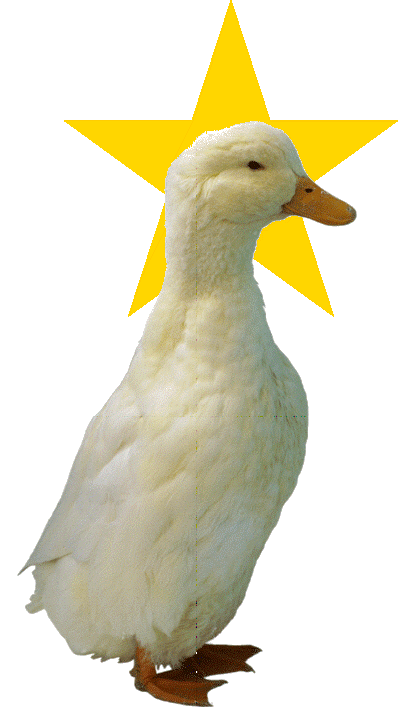Clasification: Heavy [First standardised in the UK 1901]

Large white ducks have long been known to be prolific across China, kept by boat people along rivers and in harbours. In 1870, A Chinese student, Chan Laisun, gave a lecture in New York referring to ducks known in his homeland as Ten Pound Ducks (referring to the weight). As a result of this, some ducklings were imported into the USA in 1873, by a John Palmer and a Mr McGrath. The same breed had been imported into the UK in 1872, reported variously as by Walter Steward, a Mr Keele and a Mr Harvey.These importations provided the basis for the differences in development of the breed between the USA and Europe, At the time, the Dutch East India Company was the only company permitted to trade into Japanese and other Far Eastern harbours, and the 'Penguin' or 'Japanese Duck' was imported into Europe.Alfred Wallace referred in 1851, to birds in Malaya and Lombok, Indonesia, that they walk erect, like penguins'. German enthusiasts began to breed the Chinese ten pound duck with the Penguin Ducks, leading to the development of the modern breed.
Meanwhile, in the USA, breeding was concentrated on developing the breed as a table bird and it became the source for the US table bird industry, being prolific layers with a clean white carcass. There was no clear focus on the posture. As a result, major differences now exist between the American and German forms.
The typical characteristic of the German Pekin is the upright stance,thick neck and the white plumage with a yellow sheen. Over the years, this yellow colour has been intensified by selective breeding.
The British Standard between 1910 and 1930 insisted on a plumage that was deep cream or 'buff canary' and when this strain 'died out' fresh importations were made from Europe. The present exhibition strain is therefore often referred to as the'German Pekin' largely to distinguish it from the American. The present day Pekins are more upright with a high skull and short beak, compared with their Victorian predecessors.
This yellow colour is seen in other white breeds, where it is seen as a negative feature, but in the Pekin it is required and can be enhanced by inclusion of maize in the feed and by restricted exposure to the bleaching effects of strong sunlight. The eyes are blue, and the bill, legs and feet bright orange. The plumage is particularly dense and rather fluffy, giving the birds a chubby facial appearance.
One description of the general shape of the Pekin is that it resembles a small, wide boat, standing almost on its stern, and the bow leaning slightly forward.
A consequence of the posture of these birds is that they cannot sit like other ducks with head tucked back between the wings - they sleep with their head straight out or to the side. There are also issues with preening - because of the thick neck, access to the preen gland is restricted. As a result, feather condition is difficult to maintain under less than ideal conditions. This and the eye infections leading to weeping eyes, particularly in drakes.

As in many domestic breeds of animals, there has been a tendency to strive for exaggerated versions of show features. As in the Runner ducks, some breeders have tried to develop the upright stance to excess, resuIting in birds which cannot keep their balance, and this can lead to issues with the tail being deformed or twisted.
This is a variety that continues to survive as an exhibition breed and also as basic stock for commercial breeding. Crossed with other breeds, it had a large impact on the commercial table bird market. In addition, it provided genetic material for several modern breeds, including the Saxony.
However, often any large white duck is referred to as Pekin (if they are not called Aylesburys!) just as random white geese are referred to Embdens and Romans.
Past DEFRA surveys of pure breeds of ducks do not highlight many returns for Pekins although, like many domestic breeds, numbers seem to fluctuate wlldlyfrom year to year and currently there are good numbers being shown.
This year (2018) at the BWA Champion Waterfowl Exhibition, 17 birds were exhibited.